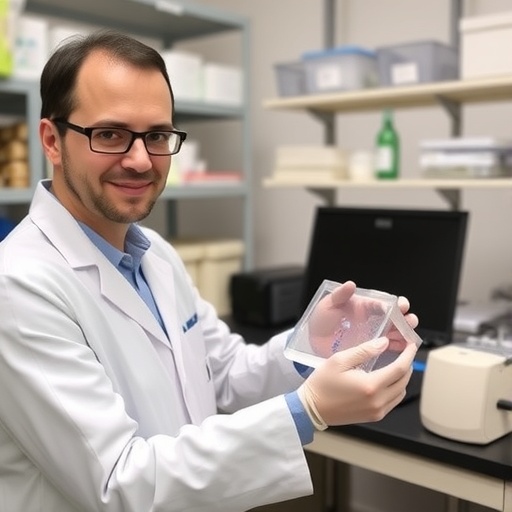Infectious diseases pose a persistent global health challenge, with early and accurate detection remaining a key determinant of patient outcomes. Recognizing this critical need, researchers at the University of Central Florida (UCF), bridging expertise from both the College of Medicine and the College of Sciences, are pioneering a transformative approach for diagnosing Hepatitis B, Hepatitis C, and HIV infections simultaneously. This innovative endeavor has garnered a significant $537,619 grant from the National Institutes of Health (NIH), underpinning the development of a low-cost, highly accurate biosensor test designed to revolutionize viral diagnostics.
Traditional methods for detecting these viruses typically rely on blood samples analyzed in centralized clinical laboratories. However, this process often proves cumbersome and inaccessible, especially in resource-constrained settings such as rural or low-income regions where laboratory infrastructure is limited or absent. Consequently, patients face prolonged wait times — sometimes months — for definitive diagnoses, during which the viruses may silently advance, exacerbating health risks and fueling further transmission within communities.
The UCF team, led by chemists Dr. Yulia Gerasimova and Dr. Karin Chumbimuni-Torres alongside infectious disease specialist Dr. Daniel Ram, is addressing these challenges by repurposing an existing electrochemical biosensor platform. This sensor is engineered to detect viral RNA sequences directly, enabling simultaneous identification and quantification of viral loads in a patient’s biospecimen. The ability to measure RNA rather than relying solely on serological markers represents a sophisticated leap forward in diagnostic precision, permitting detection even in the earliest stages of infection before immune responses become pronounced.
This dual-purpose biosensor capitalizes on isothermal amplification techniques, a molecular biology process that amplifies viral nucleic acids at a constant temperature. By simplifying amplification dynamics, this approach circumvents the complexity and equipment demands of traditional polymerase chain reaction (PCR) machines, making it especially conducive to field deployment. Virus-specific probes embedded in the sensor facilitate precise recognition of genetic signatures from both Hepatitis viruses and HIV, enabling the assay to distinguish co-infections within a single test—an advancement critical for tailoring patient treatment regimens.
The rationale for simultaneous detection is underscored by epidemiological realities. Hepatitis B and C jointly afflict over 300 million individuals globally, while upwards of 40 million people live with HIV, according to World Health Organization data. The overlapping transmission routes of these viruses – predominantly via blood and bodily fluids – predispose individuals to co-infections, complicating clinical management. As Dr. Gerasimova notes, detecting these pathogens together informs clinicians’ therapeutic decisions and enhances patient prognosis by addressing multifaceted infection dynamics in real-time.
Conventional diagnostic workflows often hinge upon separate tests for each virus, prolonging diagnosis and increasing healthcare costs. In contrast, the electrochemical biosensor’s rapid turnaround times and multiplexing capabilities promise substantial gains in efficiency and accessibility. Dr. Ram, recalling his childhood experiences in Guyana, poignantly highlights the real-world implications of diagnostic delays. Samples frequently had to be shipped offshore due to inadequate on-site testing facilities, introducing risk of sample degradation and treatment postponements—hindrances that the new biosensor technology aims to abolish.
Utilizing an electrochemical modality, the biosensor transduces RNA binding events into measurable electrical signals. This sensitive bio-recognition strategy not only enables detection of multiple viral serotypes but also accommodates the significant genetic variability characteristic of HIV. The sensor’s adaptability ensures resilience against viral mutation-driven diagnostic blind spots, a feature vital for sustaining long-term test reliability amidst evolving viral populations.
In addition to diagnostic applications, quantification of viral loads provides clinicians with critical insights for monitoring disease progression and evaluating therapeutic efficacy. Such granularity facilitates personalized medicine approaches, adjusting antiviral regimens according to patient-specific viral burdens. This represents a marked improvement over conventional antibody-based assays, which often only indicate exposure but fall short of defining active viral replication intensity.
The collaborative project is still at the exploratory stage, with ongoing efforts focused on validating biosensor performance using cell culture models and establishing detection thresholds corresponding to clinically relevant viral concentrations. Dr. Chumbimuni-Torres’ prior successes in adapting similar sensor technology for arboviral diseases like dengue and Zika bolster confidence in the approach’s translational potential. Once optimized, the biosensor promises to be an indispensable tool for epidemiological surveillance and point-of-care diagnostics, especially in under-served regions.
Beyond immediate scientific advancements, the initiative underscores a broader imperative of democratizing healthcare technology. By prioritizing low-cost, portable, and user-friendly design principles, the UCF team aspires to surmount economic and infrastructural barriers that disproportionately affect marginalized populations. Implementing such technologies on a global scale could markedly reduce viral transmission, enhance early intervention, and ultimately alleviate the burden of chronic infections that strain healthcare systems worldwide.
In summary, this multidisciplinary collaboration at UCF exemplifies the power of integrating chemical sensor innovation with clinical infectious disease expertise. By harnessing electrochemical biosensing and isothermal nucleic acid amplification, the team is charting a path toward rapid, multiplexed viral detection that is accessible in virtually any healthcare context. Their work promises not only to transform diagnostics for Hepatitis B, Hepatitis C, and HIV but also to serve as a blueprint for combating other infectious diseases in the 21st century.
—
Subject of Research: Development of an electrochemical biosensor for simultaneous detection and quantification of Hepatitis B, Hepatitis C, and HIV at the RNA level.
Article Title: Repurposing Electrochemical Biosensors for Rapid, Multiplexed Detection of Hepatitis and HIV Viruses
News Publication Date: Not specified
Web References: https://med.ucf.edu/
References: NIH/National Institutes of Health grant information (specific grant number not provided)
Image Credits: Photo by UCF




